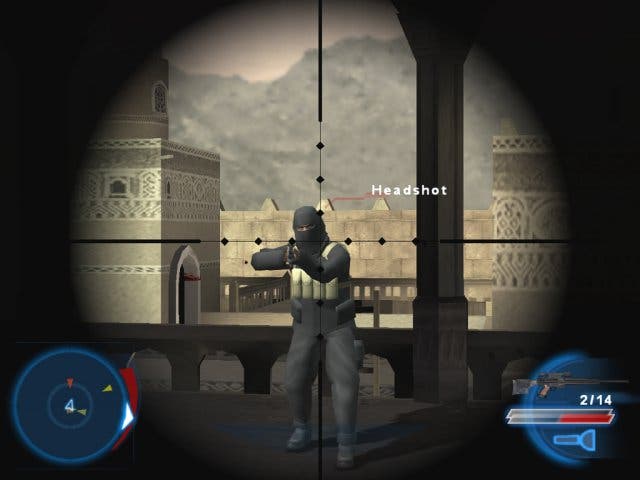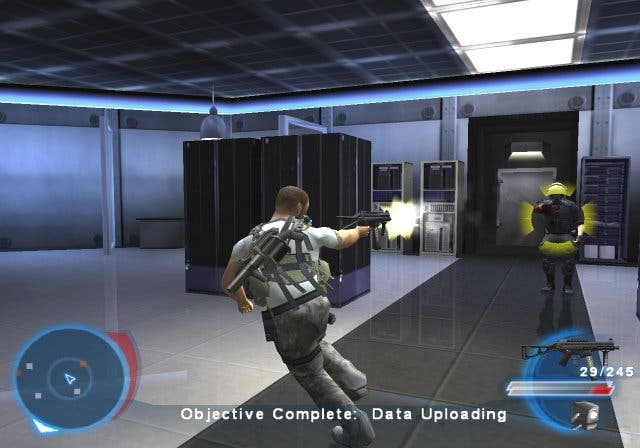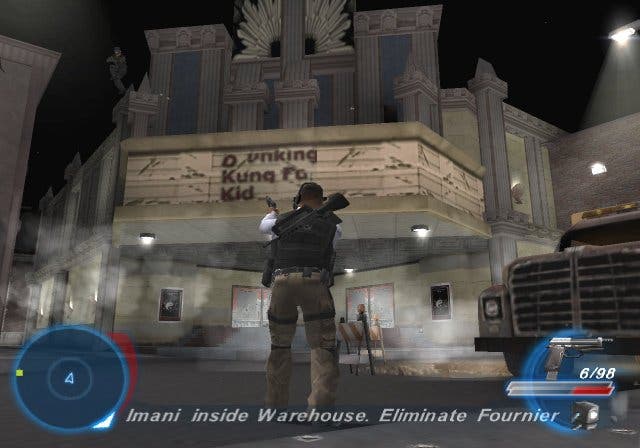Syphon Filter: The Omega Strain
Kristan returns from the mud to fight gaming terrorism once again.
Order yours now from Simply Games.
It's fair to say that we demand a lot out of games these days; great graphics with convincing animation, gripping storylines voiced by (preferably) known actors, and most of all gameplay that has us anchored to our seats that's as fun as it is challenging. It's also more than fair to say that Syphon Filter: The Omega Strain fails on all three counts thanks to what can only be surmised as a complete lack of ambition to push the series forward in the most crucial areas, while wasting its time designing the whole thing around online play.
Whereas the previous three titles in the series focused on the exploits of Gabe Logan, a sort of Sam Fisher of the 90s, this time we're forced to customise our own fat arsed agent and waddle around carrying out a multitude of tasks for Logan's crime busting organisation around the world. In thoroughly hackneyed done-to-death style, we're chasing down a bunch of miscreants responsible for creating a virus that's going to kill us all, which in gaming terms effectively means heading for waypoints, shooting an endless procession of armed-to-the-teeth drones and activating switches - much like any other action adventure you've played over the past ten years.
Where's Phil Collins when you need him?

The Omega Strain as a one-player experience is an against-the-odds task, largely thanks to some curious design decisions that arbitrarily extend the playing time of each level by three or four times as much. Instead of designing tight, focused levels with enemies that need to be carefully disposed of, Omega Strain prefers to give the player vast sprawling environments to roam which continually throw respawning enemies at them. A ten-minute par time level could easily take you over an hour on your first attempt while you figure out which way to head, and 'enjoy' fighting the respawning hordes over and over again.
Once you achieve anything of note, the game sensibly checkpoints your progress, and dumps you back there when you die - albeit with the same ammo as when you died, and with the double whammy of all the enemies you've just slain mostly reappearing. We say 'mostly', because the game is utterly inconsistent as to when it chooses to repopulate your immediate environment or not. Sometimes you have a long empty slog to endure, sometimes the whole battle - but generally you're looking at 150 plus kills per level thanks to this ill-conceived mechanic, which adds up to a whole lot of wasted time and a stupendous number of deaths into the bargain. It's like playing a game on infinite lives, but having the handicap of restricted ammo. Why on earth didn't they plump for the traditional checkpoint system implemented as standard in almost every other action adventure?
The answer only becomes apparent when you consider that The Omega Strain was designed from the ground up as a four player co-operative online multiplayer game; one which requires the game to respawn dead players so that the flow of the game isn't broken. So while the game's structure makes sense online, offline solo player suffers immensely as a result, and tasks which should take you no more than 10 or 20 minutes suddenly balloon into tiresome slogs that pad out the experience beyond all logical reason. While we can understand why they chose to focus on online play, it doesn't make it any easier to bear when you're being overwhelmed by respawning AI who all seem to have unlimited ammo, while you're down to your last pistol clip. In solo mode, not only is it plainly not very enjoyable, but that it evidently wasn't even designed to be a single player game just adds insult to your injury addled body.
Needle in a haystack

Unlike, say, Splinter Cell: Pandora Tomorrow with its distinct single player mode and specifically designed online play, The Omega Strain attempts to shoehorn both forms of play into the same game, and it simply doesn't come off. The fact that you can dip into your ongoing single player campaign in multiplayer mode is a nice touch, but in our experience, finding three other experienced players to join you in a specific map at the same time is a task that requires far more patience than it should. Headset support makes the issue of relaying instructions a doddle, but it's not a game that novices could reasonably expect to just jump into, mainly because each map is surprisingly vast, and requires a working knowledge of the layout and enemy spawn points before simply wading in unprepared. A swift return to your own spawn point is assured.
Although it would be polite to describe the game's visuals as acceptable, you can't help but wonder why the team went for such an ostensibly basic look throughout. As big as they are, the playing environments are largely bland and repetitive, and suffer from a uniform lack of texturing consistent with an early PS2 look that's positively years out of date next to recent efforts. To make matters worse, the chunky, hip-swivelling, Wayne Rooney-esque character models are on the same kind of level; acceptable in that they represent the basic movements, but in a way that has observers either laughing or wincing, or a mixture of the two.
In the game's favour, the two-pronged third-person targeting system makes the endless combat much less of a chore than it other wise could be. Holding down R1 locks on to your enemy, but rather than simply instantly tagging your target, the amount of time it takes to change from a red reticule to yellow then to green varies depending on the weapon, giving a sensible impression of the heavier, bulkier weapons taking more time to line up. Meanwhile, though, you can strafe and roll while keeping your target firmly in your sights before unleashing a hail of bullets when the time is right.
The whole wide world went Zoom

Pressing L1, however, zooms in the view slightly and enables you to pull off more accurate one-shot kills, but presents a greater risk thanks to the fact that you can't move at the same time. Between them, the two fire modes come in handy at different times, and used in conjunction with the lean, roll, crouch and strafe makes for a versatile combat system that takes a bit of getting used to, but is solid twist on the standard mechanics used elsewhere. It's just a shame, then, that the combat is a little meaningless after a while, with an endless sea of headless chicken enemies streaming towards you inexorably. There is a rudimentary sense of AI from the drones, with a smattering of duck and cover tactics employed, but it's a pretty transparent system that doesn't take a lot of figuring out, depressingly. It's not exactly Halo, put it that way - and almost three years on from Bungie's celebrated title, shouldn't advanced enemy behaviour be a standard feature by now, or should we just politely accept PSone era mediocrity such as this?
As nice as it is to see the between mission Zeus files, with lovingly designed notes, mails and files delivering a smidgen of storyline immersion, there's a parallel sense of utter confusion as to who's doing what, when and where. It's information overload, and with some truly dreadful 32-bit era cut-scenes (and not very good ones at that), and endless radio chatter during the mission, it prompts almost instant disinterest. Without wishing to be unkind, The Omega Strain tries hard to get you into the proceedings, but even ten hours in you're just as disconnected from the events as you were in the beginning, as the game turns into a repetitive slog of chasing waypoints, dying multiple deaths and engaging in almost constant and less than entertaining shoot outs. Add to that a repetitive and utterly generic soundtrack that could have been lifted from any action game ever made in the last decade and the effect is complete: you're forced to reach for the off switch.
Lone ranger
As we enter the fifth year of the PS2, gamers ought to be banging on the pristine glass of Sony Computer Entertainment's HQ and demanding more for their cash from the format holder, the very company that's in charge of its gaming output and ought to have a better handle on the inner workings of its system than any other company - in the same way that Sega and Nintendo used to. Instead we're expected to part with our hard-earned cash for a game you'd have difficulty being interested in if it was being released by Play It or Midas for almost no money. This empty feeling you get from playing The Omega Strain will be etched all over your drained face within minutes - it's a depressingly bland experience, and frankly not one we'd advise anyone but the most committed online console gamer to even bother having a look at. It's by no means the worst game we've played all year, and played in its native online mode improves it a further notch, but the bottom line is that PS2 owners deserve so much more than a generic action game at this stage - especially one where playing it alone presents a massive disadvantage.
Order yours now from Simply Games.








